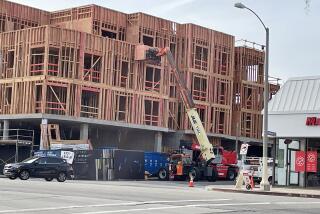Panel Approves Law Reducing Visual Impact of Cellular Sites
- Share via
THOUSAND OAKS — Hoping to prevent an onslaught of hillside structures, the Planning Commission has approved a law aimed at reducing visual pollution caused by cellular antennas.
The law was drafted in response to a surge in requests by phone companies to locate cellular antennas in Thousand Oaks. City Council members enacted a moratorium on new wireless communications sites in November.
In the meantime, planners drew up the law to accommodate the growing use of cellular phones while protecting the city’s rolling hillsides.
Under the new plan, developers would be required to take numerous steps to mitigate the structures’ impact, such as painting antennas to match the environment and placing landscaping around the transmission sites. In addition, companies would have to provide documents showing that the antennas meet Federal Communications Commission safety guidelines for electromagnetic radiation.
Moreover, companies would have to submit plans detailing the areas in Thousand Oaks where they might build wireless sites in the future.
And all new proposals would come before the Planning Commission.
The law defines wireless facilities as sites with antennas, microwave dishes, towers, poles, equipment shelters, support structures and other equipment. At present, some wireless projects can be approved without public discussion, officials said.
“I think we did the right thing,” said Planning Commissioner Dave Anderson, referring to the 4-1 vote taken Monday night. “On a case-by-case basis, we’ll be effective at making [phone companies] hide these things. . . . It will cost them money, but that’s their problem.”
AT&T; officials, who want to build a wireless site near Meadows Reservoir in partnership with Pacific Bell, called the proposed law fair. But they plan to challenge the provision requiring companies to disclose future locations when the proposed law goes before the City Council.
“We understand that Thousand Oaks wants to plan,” said Jon Morris, real estate manager for AT&T; in Ventura County. “But we don’t want to lose our competitive advantage.”
Planning Commissioner Ronald Polanski argued that the proposed law does not go far enough. He wanted to ensure that wireless sites are not built in open space and residential areas.
“I would have liked to have seen it taken a step further,” Polanski said. “The problem is, we don’t know how many [antennas phone companies] will need,” he added. “If it’s not done carefully, we’ll have antenna farms throughout the city.”
The Thousand Oaks law requires approval from the City Council before it can take effect.
Simi Valley has already approved regulations on cellular antenna construction, and county officials are considering new guidelines for unincorporated areas.
“As opposed to oak trees and deers, I don’t want to stare at antennas,” said Polanski, who lives in the gated community of Lynnmere. “I’d hate to see one by my house. I’d fight it all I could.”
More to Read
Sign up for Essential California
The most important California stories and recommendations in your inbox every morning.
You may occasionally receive promotional content from the Los Angeles Times.










